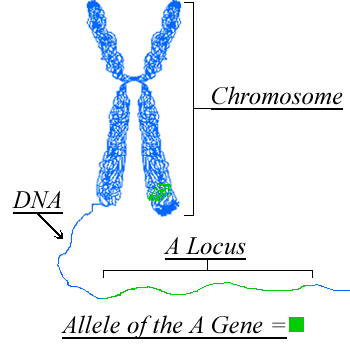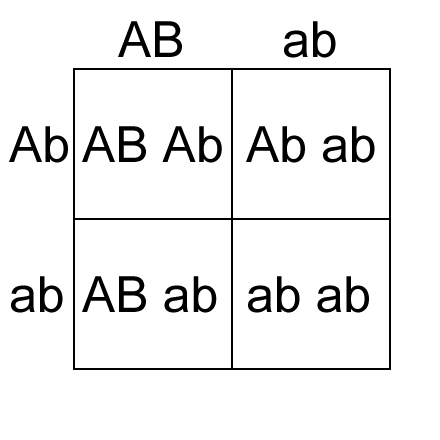This post was designed to be a quick guide to help explain some of the basics of coat color genetics: including basic concepts, and vocabulary. Many animal breeders shy away from genetics, thinking it is either not necessary or that genetics are too complicated to be worth while. I believe that it is important to understand the genetics of the animals you breed. Even if it is something as seemingly trivial as color genetics, it will pave the way to helping you understand the inheritance of other traits so that you can do your part for improving the health, appearance, and overall quality of the species.
What are Genes?
A gene is a small piece of a big molecule called DNA, and exist inside living cells in a ‘wound-up’ DNA molecule known as a chromatid— two identical sister chromatids are joined together to form the structure known as a chromosome.
DNA is a molecule, but is also a type of code that can be compared to an instruction manual. Mechanisms inside a cell read the DNA, which instructs the cell to make a product or perform a task.
In color genetics, symbols (usually a letter) are used to refer to a gene’s location within the DNA molecule. These locations are called loci (singular: locus). For example, the ‘A locus’ of mammal colors is the location of the Agouti gene (agouti is a trait that causes bands of different colors to occur in each hair).

One gene can have multiple variations, and these variations can result in very different outcomes for the animal. These variant forms of a gene are called alleles. The alleles of the Agouti gene that we will discussed here are A (agouti), and a (not agouti).
An individual inherits its genes directly from both of its parents, because of this everyone will have two alleles for each locus. The combination of these two alleles is known as the genotype. If an individual inherits an A allele from its mother and an a allele from its father then its genotype for the A locus is Aa.

Basic Terminology
Dominant and Recessive
When there are two different alleles at a locus, such as with the genotype Aa, it is often the case that only one of the alleles will show a noticeable result in the individual’s physical appearance. This is because of the phenomenon known as dominant and recessive expression. If an allele expresses when there is only one copy of it in the genotype then it is classed as a dominant gene. While an allele that only expresses when it has two copies in the genotype is classed as a recessive gene.
Dominant alleles are traditionally written in caps, while recessive alleles are lower case. If there are more than two alleles present at a locus, then superscript is used to distinguish between the multiple alleles and the hierarchy becomes less obvious (E.g. Aw,Ay,a).
For the Agouti locus the A allele is dominant, while the a allele is recessive. So an individual with the genotype AA or Aa will be agouti colored, while an individual with the genotype aa will be non agouti, i.e. solid colored.
Phenotype and Genotype
The genetic term for the physical appearance of an individual (such as color) is ‘phenotype‘. An individual with the genotype Aa is said to have an Agouti phenotype, while an individual with the genotype aa is said to have a non-agouti phenotype.
Genotype = The actual genetics of an individual.
Phenotype = The visible expression of an individual’s genotype.
Homozygous and Heterozyous
These are the terms used to describe whether or not a genotype is composed of like alleles. If a genotype is composed of like alleles (such as AA or aa), then it is said to be a homozygous genotype. If a genotype is composed of two different alleles (such as Aa), then it is said to be a heterozygous genotype. It is quite common in the world of color breeding to hear people use the abbreviation ‘het’ when referring to an animal with a heterozygous genotype for a desired recessive trait.
Terminology Summarized
| Allele-Match | Genotype | Phenotype |
| Homozygous | AA | Agouti |
| Heterozygous | Aa | Agouti |
| Homozygous | aa | Not Agouti |
Inheritance
Inheritance can get complicated, but coat color inheritance is often a very simple mechanism: when two individuals are crossed, half of each of their genotypes goes to their offspring. This means that if an individual has the genotype Aa, then it will pass either an A or an a to each offspring; while the offspring would get the second half of its genotype from the other parent. Where the process can get complicated is when considering more than one locus.
The B locus is the location of the Black/Brown gene, of which two alleles will be discussed for this tutorial: the dominant B allele (black) and the recessive b allele (reduced to brown). The agouti locus is epistatic to the B locus, which means it changes the normal expressions of the B locus, or in other words, the expression of the B locus is reliant on the affects of the A locus.
The genotype {AA BB} will produce a black agouti, sometimes called golden agouti or brown (hairs are banded by black and tan/orange, like a brown tabby cat), while the genotype {AA bb} will produce a brown agouti, very commonly known as a cinnamon (hairs are banded by brown and tan/orange). However, without the dominant agouti gene the banding affect goes away; the genotype {aa BB} will produce a solid black colored individual, while the genotype {aa bb} will produce a solid brown colored individual.
Many more traits can be taken into consideration to get an even larger and more complex genotype. The main color loci in most mammals are A (agouti), B (brown), C (albinism), D (dilution), and E (color extension).
Punnett Squares
The chance that an offspring has of inheriting certain allele combinations from its parents are frequently determined using a tool called a Punnett Square. This simple tool shows which allele combinations are possible in a particular cross.
For an example, say two individuals are crossed, and one is black with the genotype BB, and the other is brown with the genotype bb. The Punnett square would be set up as is shown below– with the genotype of one parent written along the top, and the genotype of the other written along one side.

Then in each box within the square combine the allele above it with the one to its left. The results can be seen in the square below. Each box represents the genotype of a potential offspring.

There is a 100% chance of getting black offspring. Each of the parents had only one allele of the B locus to give, the one whose genotype is written across the top of the square could only give a B allele, while the other parent, whose genotype is written on the left side of the square could only give a b allele.
If you were to cross two individuals who both had the genotype Bb, then the results would be as follows.

Each baby born from this cross would have a 50% chance of being heterozygous black, a 25% chance of being homozygous black, and a 25% chance of being brown (overall, an offspring of this cross would have a 75% chance of being black colored, and a 25% chance of being brown colored; i.e. the cross yields a 1/4 chance of producing brown).
Now let’s will look at multiple genes. If you are wanting to track traits from more than one gene, then you can either set up multiple Punnett squares and divide the percentages down to the final statistics, or you can combine the genotypes into a single large square, see below.
For this example lets go back to our Agouti and Black genes. If we were to cross two individuals with genotypes {Aa Bb} and {Aa bb} (a het black agouti, and a brown agouti), then we would begin by factoring the genotypes of each parent, and then apply those to the square. Parent number one with the genotype {Aa Bb} can give the following combinations to its offspring: A B, A b, a B, and a b. Parent 2 with the genotype {Aa bb} can give: A b, A b, a b, and a b. We will put parent one along the top of the square, and parent two on the side.

| Black Agouti | 6/16 | 37.5% |
| Brown Agouti | 6/16 | 37.5% |
| Solid Black | 2/16 | 12.5% |
| Solid Brown | 2/16 | 12.5% |
Due to the fact that the genes are combined randomly, the percentages that a Punnett square calculates do not apply to each litter. In other words, one litter from the cross above could consist of all solid colored offspring, but if the cross is repeated many times, then the percentages from all of the crosses will begin to converge on those of the Punnett square. Punnett square determines the percentages produced from crosses within a population, or the probability per individual.
Simply put, the Punnett square is just a tool: it is very useful to see which colors are possible in a cross, and which of those is more likely to occur. It does not make predictions.
Linked Genes
So far we have seen that multiple traits are assorted independently; where {Aa Bb} crossed with {Aa bb} yields the product of two independent ratios 1AA:2Aa:1aa x 1Bb:1bb. However, if the A-locus and the B-locus were close to each other on the same chromosome, then the allele combinations between the two loci would remain the same from one generation to the next. They would not be independently sorted and would then be called linked genes (this is just for an example, the black and agouti traits are not linked in any animals that I am aware of)
The genotype of linked traits is written differently; since the two alleles of different loci are linked together they must be written in a way that shows this linkage. For example, if one individual had inherited an A allele and a B allele next to each other on the same chromosome from one parent, and from the other parent they inherited a chromosome with an a allele next to a b allele then that individual’s genotype for these two loci would be written as {AB/ab}. This shows that on one chromosome the dominant allele of the A-locus is linked to the dominant allele of the B-locus, while on the other chromosome the recessive alleles of the two loci are linked.
If A and B were linked and the above cross were made, then the outcome would be very different. I will now set up the same cross again, this time showing that the two loci are linked.

| Black Agouti | 2/4 | 50% |
| Brown Agouti | 1/4 | 25% |
| Solid Brown | 1/4 | 25% |
As you can see, the result is greatly different when the traits are linked together. Since the only B allele is linked to an A allele, it is impossible to get a solid black from this cross. But fortunately, the black and agouti traits are not actually linked.
Unfortunately, if you are tracking linked traits, then there is no shortcut method of figuring out the allele combinations, you will have to keep detailed color-pedigrees and track the genotypes of each generation.

One thought on “Introduction to Color Genetics”